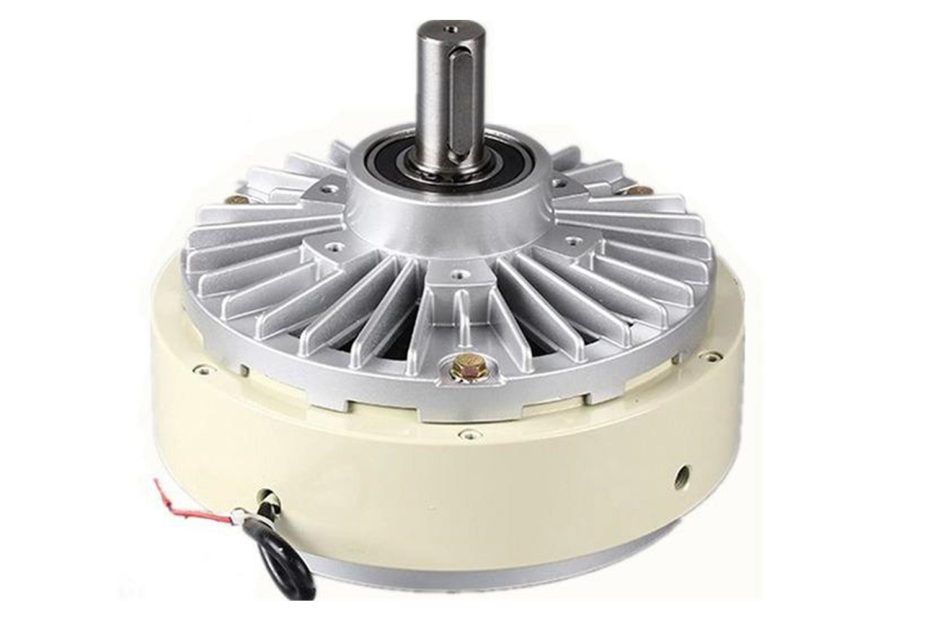Magnetic Particle Brakes is an electromagnetic brake that uses the principle of magnetic Particle sliding energy consumption to control the braking torque within a certain range. They are widely used in printing machinery, packaging machinery, and sewing equipment. , textile machinery and other fields.
Magnetic Particle brake is mainly composed of rotor, stator, electromagnetic coil, magnetic Particle, junction box, etc. Magnetic Particle brakes have the characteristics of fast braking response, strong braking processing capability, and high precision.
Magnetic Particle brakes are indispensable components in various industrial applications, contributing to controlled torque and rotational speed. However, users often observe that magnetic Particle brakes can become hot after extended use, raising questions about their functioning and safety.
Magnetic Particle brakes are devices that control torque and rotational speed by applying a variable magnetic field to engage or disengage a Particled material (typically iron particles) within the brake assembly. This engagement or disengagement of the Particled material results in resistance, generating the necessary control over the rotation of a driven component.
The Heating Phenomenon
Magnetic Particle brakes exhibit a heating phenomenon during extended use, and this is not unusual. The primary reasons for this heating include:
- Frictional Heat : As the magnetic field engages the iron particles within the brake, friction occurs. This frictional force generates heat, which can increase over time during continuous operation.
- Eddy Currents: In the presence of a changing magnetic field, eddy currents are induced in the metal components of the brake, leading to heat generation. Eddy currents are a result of electromagnetic induction and contribute to the overall temperature rise.
Auto-Cooling Mechanisms
One of the intriguing aspects of magnetic Particle brakes is their ability to auto-cool during operation, preventing overheating and ensuring consistent performance. This automatic cooling is facilitated by the following mechanisms:
- Ventilation : Most magnetic Particle brakes are designed with built-in ventilation systems. These systems consist of small openings or vents that allow ambient air to flow through the brake assembly during operation. This air circulation helps dissipate the heat generated by friction and eddy currents.
- Heat Dissipation : The design of magnetic Particle brakes incorporates materials with high thermal conductivity. This enables efficient heat dissipation as the heat generated by the brake’s operation is conducted away from the core components and into the surrounding structure, which acts as a heat sink.
- Thermal Sensors : Many modern magnetic Particle brakes are equipped with thermal sensors. These sensors continuously monitor the temperature of the brake during operation. When the temperature exceeds a predefined safe limit, the brake’s control system can automatically reduce the magnetic field, allowing the brake to cool down.
- Duty Cycle Control : Duty cycle control is a crucial feature that helps manage the heating of magnetic Particle brakes. By controlling the duration of engagement and disengagement cycles, users can mitigate excessive heating. For applications with high torque requirements, the duty cycle can be adjusted to prevent the brake from overheating.
Top 4 Applications of Magnetic Particle brake
magnetic Particle brakes to deliver precise torque control, automatic cooling, and consistent performance over extended periods.
Magnetic Particle brakes are widely used in various industries due to their unique combination of torque control and automatic cooling.
- Printing: Magnetic Particle brakes play a critical role in controlling the tension of web materials in printing machines, ensuring precise and consistent print quality.
- Packaging: Packaging machinery relies on magnetic Particle brakes to control the unwinding and winding of packaging materials, facilitating precise and reliable packaging processes.
- Tension Control: In processes like wire drawing, coil winding, and film production, magnetic Particle brakes maintain consistent tension, resulting in high-quality end products.
- Textile Industry: The textile industry uses magnetic Particle brakes to control the tension of fabrics during processes like weaving and coating.

Proper Maintenance and Care
While magnetic Particle brakes are designed for automatic cooling and reliable performance, it’s essential to follow best practices for their maintenance and care:
- Regular Inspection: Periodically inspect the brake for any signs of wear, damage, or debris that may impede ventilation.
- Cleanliness: Keep the brake and its surroundings clean to ensure unobstructed airflow for effective cooling.
- Lubrication: Lubricate moving parts and ensure that the brake’s mechanical components are in good working condition.
- Temperature Monitoring: Continuously monitor the brake’s temperature using any built-in thermal sensors or external monitoring systems to prevent overheating.
- Appropriate Sizing: Ensure that the magnetic Particle brake is appropriately sized for the application to prevent excessive heating.
Conclusion
Magnetic Particle brakes provide a valuable solution for torque control in various industrial applications. While they may heat up during prolonged use, they are equipped with built-in mechanisms for automatic cooling, ensuring safe and reliable operation.
Understanding the reasons for heating and the auto-cooling mechanisms is essential for efficient and trouble-free use of magnetic Particle brakes in diverse industrial settings. Proper maintenance and care further enhance their longevity and performance, making them a dependable choice for applications that demand precise torque control.
